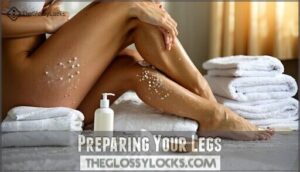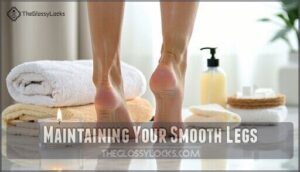This site is supported by our readers. We may earn a commission, at no cost to you, if you purchase through links.

You’ll want to exfoliate first, then clean your skin thoroughly.
Choose between hard wax for sensitive areas or soft wax with strips for larger sections.
Heat your wax to honey consistency, apply it in the direction of hair growth, then pull strips off quickly against the grain.
It’s like ripping off a Band-Aid – hesitation only makes it worse.
Post-wax care involves soothing lotions and avoiding hot showers.
The real game-changer lies in perfecting your technique and timing.
Table Of Contents
- Key Takeaways
- How to Wax Your Legs at Home?
- Preparing Your Legs
- Setting Up Your Waxing Space
- Choosing The Right Wax Product
- Testing The Wax First
- Applying Wax Correctly
- Removing The Wax Strips
- After-Wax Care Tips
- Dealing With Ingrown Hairs
- Maintaining Your Smooth Legs
- Frequently Asked Questions (FAQs)
- Can you wax your legs by yourself?
- Should I wax my legs up or down?
- What kind of wax is best for legs?
- How do you prepare your legs for waxing at home?
- How to wax under legs at home for beginners?
- Is it worth it to wax your legs at home?
- Do you wax your legs before or after a shower?
- How often should I wax my legs?
- Can I wax my legs if pregnant?
- Will waxing my legs cause skin damage?
- Conclusion
Key Takeaways
- Prepare your legs properly – Exfoliate 24 hours before waxing, ensure hair is about a quarter-inch long, and clean your skin thoroughly without moisturizer on wax day for better wax grip.
- Master the application technique – Heat wax to a honey consistency, apply thin layers following the hair growth direction, then pull strips quickly against the grain while keeping skin taut.
- Follow essential aftercare steps – Skip hot showers for 24 hours, apply cooling aloe vera immediately, and exfoliate every other day with gentle methods to prevent ingrown hairs.
- Maintain your results consistently – Wax every 3-4 weeks, moisturize daily, use SPF protection, and consider hair growth inhibitor serums between sessions to extend smoothness.
How to Wax Your Legs at Home?
Waxing your legs at home isn’t rocket science, but it does require some prep work and the right technique. Start by exfoliating 24 hours before and skip the moisturizer on wax day – you want clean, dry skin for maximum grip.
Set up your space with good lighting and proper ventilation. Choose between DIY wax recipes like sugar-based options or store-bought kits, considering your skin sensitivity to minimize waxing side effects.
Always do a patch test first for waxing scar prevention. Heat your wax evenly, apply with a wooden spatula following hair growth direction, then remove strips swiftly against the grain.
The best at home leg wax technique combines patience with confidence – don’t second-guess yourself when pulling those strips!
Preparing Your Legs
Your legs need some TLC before you start your leg waxing at home adventure. Think of waxing preparation like prepping a canvas – you want everything smooth and ready.
Think of your legs like a blank canvas – prime them right, and your wax will glide on like a masterpiece.
Start with exfoliation timing about 24 hours before waxing. Grab a gentle scrub and buff away dead skin cells. This simple step helps the wax grab hair better and reduces irritation later.
Check your hair length – you’ll need about a quarter-inch for the wax to work its magic. Too short? The wax won’t catch. Too long? Trim it down with scissors.
Skip heavy moisturizers on waxing day. Instead, focus on skin cleansing with a gentle wash. Pat dry and dust on some baby powder to absorb oils and reduce sensitivity.
Don’t forget allergy testing if you’re trying new products. Test a small patch first – your skin will thank you for this extra skin care step.
Setting Up Your Waxing Space
You’re about to turn your bathroom into a mini spa, so let’s set the stage right. Cleanliness Importance can’t be overstated – sanitize your surfaces and wash your hands thoroughly before starting your DIY leg wax session.
Lighting Considerations matter more than you’d think; bright, even lighting helps you spot every stubborn hair and avoid missing patches.
Create your Ergonomic Setup with a sturdy chair where you can comfortably prop your leg. Privacy Needs are essential – lock that door and maybe put on some music to feel relaxed.
Lay down old towels to protect your floors from wax drips.
Keep your Essential Supplies within arm’s reach: wax, applicators, strips, and a small trash bin for used materials. Good ventilation prevents that stuffy feeling during your waxing preparation.
This thoughtful waxing tools arrangement makes your leg waxing at home experience smoother and more professional, setting you up for success before you even heat the wax.
Choosing The Right Wax Product
You’ve got tons of wax options out there, and trust me, picking the wrong one is like choosing the wrong Netflix show for date night – it’s gonna be a mess.
The key is matching your wax type to your skin’s personality, whether you need something gentle for sensitive skin or a heavy-duty formula that can tackle those stubborn hairs.
Wax Types Comparison
Understanding different wax types transforms your leg waxing game completely.
Soft wax excels on larger areas like legs, covering efficiently while grabbing fine hairs with strips.
Hard wax works best for sensitive spots but takes longer for full leg coverage.
Sugar waxing offers gentler removal using natural ingredients, while vegan options and CBD infused formulas reduce irritation for sensitive skin.
Some waxes, like paraffin, can release harmful toxins when burned, so consider your options carefully.
- Never again wonder which wax will work best for your unique needs
- Feel confident knowing you’re choosing the perfect formula for smooth results
- Experience the satisfaction of mastering professional-quality leg waxing at home
Skin Sensitivity Considerations
Your skin’s unique needs should guide your wax type selection. Different formulations work better for various sensitivity levels, helping with pain management and redness control while preventing allergic reactions.
Patch testing remains non-negotiable – apply a small amount 24 hours before your session. This simple step prevents scarring prevention issues and identifies potential skin irritation before it becomes problematic.
For sensitive skin, it’s essential to recognize that waxing may cause lifting, so extra care is needed.
| Skin Type | Recommended Approach |
|---|---|
| Sensitive | Use waxing for sensitive skin formulas with calendula |
| Normal | Standard wax works fine with proper prep |
| Dry | Focus on skin moisturizing before and after |
| Reactive | Choose hypoallergenic options for skin soothing |
| All Types | Always test first – your skin’s happiness depends on it |
DIY Kit Recommendations
Once you’ve considered your skin’s needs, picking the right DIY waxing kits becomes your next mission.
Here are five top-rated options for athome leg waxing:
- Athena Club – Heat-free strips with minimal prep and effortless cleanup
- Happy Waxing Premium Kit – Perfect for beginners, includes hard wax beans and tutorial videos
- Nair Roll-On – Least painful option with sticky, reusable strips
- Body Wax Kit – Allure’s 2024 winner with soothing after-care cloths
- Kotamu Kit – Budget-friendly vegan options for long-term savings.
Consider using these waxing products for ideal results.
Testing The Wax First
Now that you’ve picked your perfect wax product, let’s talk about something that’ll save your skin – literally. Before you go full steam ahead with your homemade leg wax or store-bought kit, you need to do a patch test. Think of it as a dress rehearsal for your legs.
Here’s your step-by-step testing guide:
| Step | Action |
|---|---|
| Temperature Check | Test a small amount on your wrist first |
| Patch Size | Apply to a quarter-sized area on your lower leg |
| Wait Period | Leave for 24 hours to check for reactions |
Start by checking the wax consistency – it should feel like warm honey, not molten lava. Apply this small test patch and wait. If you notice a waxy residue forming, discontinue use immediately.
Allergy concerns are real, and skin reactions can range from mild redness to angry welts. This simple waxing patch test prevents turning your DIY waxing adventure into a skincare nightmare. Trust me, your legs will thank you later.
Applying Wax Correctly
Perfect wax temperature makes all the difference when you’re waxing legs yourself. Heat your wax to that ideal thick honey consistency—not too hot, not too cool. Think of it like Goldilocks finding the perfect porridge.
Here’s your foolproof application strategy:
- Apply thin, even layers using your wooden spatula in the hair growth direction
- Work in small sections to maintain control and prevent messy drips
- Press firmly but gently during strip application to guarantee good adhesion
Your waxing application technique determines everything. Move that spatula like you’re spreading peanut butter on toast—smooth and consistent. Pressure application should be firm enough to grip every hair but gentle enough to avoid skin irritation.
Keep checking your wax temperature as you work. Using the right tools aids application is important. These homemade leg wax sessions require patience, but following proper waxing direction and avoiding re-waxing the same spot prevents burns and irritation.
Removing The Wax Strips
Once you’ve got your wax perfectly applied, it’s showtime for the real test. Here’s where technique makes all the difference between smooth success and painful disaster.
Grip your waxing strips with confidence – you’ll want a firm hold near the edge closest to your ankle. Keep your skin taut with your free hand, pulling it parallel to create tension. This isn’t the time to be gentle.
Pull the strip against the hair growth direction in one swift, decisive motion. Think ripping off a Band-Aid, not peeling an orange.
Your pulling speed matters more than you’d think. Too slow means more pain and missed hairs. Too fast can leave you with broken hairs instead of clean removal.
| Technique | Best Practice |
|---|---|
| Strip Direction | Against hair growth, toward your body |
| Proper Grip | Firm hold near ankle-side edge |
| Pulling Speed | Quick, decisive motion |
| Skin Tension | Keep skin taut and parallel |
Don’t panic about leftover residue – that’s normal and easily handled next.
After-Wax Care Tips
Once you’ve pulled off those wax strips, your skin needs some TLC to prevent irritation and keep things smooth.
Skip hot showers and sun exposure for 24 hours—your freshly waxed skin isn’t ready for that heat yet. Loose clothing becomes your best friend, helping reduce redness while allowing your skin to breathe.
Here’s your waxing aftercare game plan:
- Apply cooling aloe vera gel immediately to soothe irritation
- Use chemical exfoliants every other day to prevent bumps
This routine keeps your legs silky and problem-free.
Dealing With Ingrown Hairs
Nobody wants bumpy, irritated skin after spending time perfecting their waxing technique. Ingrown hairs happen when hair grows back into the skin instead of breaking through the surface, creating those annoying red bumps that can ruin your smooth results.
Remember: The secret to flawless legs isn’t just the wax—it’s what you do after that counts.
Start your ingrown prevention routine 48 hours after waxing. Use gentle exfoliation methods like a soft brush or washcloth with warm water twice weekly. Chemical exfoliants** containing salicylic acid work better than harsh scrubs – they dissolve dead skin without causing micro-tears.
When you spot an ingrown hair, don’t pick at it. Apply a warm compress for 10 minutes to soften the area, then gently massage with circular motions. Tea tree oil mixed with coconut oil works wonders for soothing irritation.
Consider investing in waxing ingrown eliminating pads with glycolic acid for stubborn cases. Your waxing aftercare routine should include a gentle waxing exfoliant every few days. Remember, patience beats picking – scar treatment is much harder than prevention.
Maintaining Your Smooth Legs
Keep your smooth legs game strong with these smart maintenance moves. Your exfoliation frequency matters more than you think – aim for 2-3 times weekly using a gentle scrub or dry brush to prevent those pesky ingrown hairs from crashing your smooth skin party.
Your moisturizing routine should become as automatic as your morning coffee, keeping skin supple and ready for your next at-home waxing session. Don’t skip sun protection either. SPF 30+ isn’t just for beach days – it prevents irritation and discoloration that can mess with your waxing schedule.
Hair growth inhibitors work like magic between sessions, slowing regrowth so you can extend that silky feeling. Here’s your maintenance playbook:
- Exfoliate 2-3 times weekly with gentle scrubs or dry brushing
- Moisturize daily with nourishing, fragrance-free lotions
- Apply SPF 30+ before sun exposure to protect sensitive skin
- Use hair growth inhibitor serums between waxing appointments
Follow these leg wax tips consistently, and you’ll master the art of smooth legs waxing like a pro. Your DIY waxing routine just got an upgrade!
Frequently Asked Questions (FAQs)
Can you wax your legs by yourself?
Like Goldilocks finding the perfect porridge, you’ll discover at-home leg waxing hits the sweet spot between salon visits.
Yes, you can absolutely wax your own legs with proper preparation, technique, and patience.
Should I wax my legs up or down?
Always apply wax in the direction your hair grows, then pull strips against the grain toward your body.
This technique grabs hair at the root for cleaner removal and fewer missed spots.
What kind of wax is best for legs?
You’ll want strip wax for your legs since it covers large areas efficiently.
Choose a formula that’s easy to wash off, like those with natural ingredients or gentle adhesives that won’t leave sticky residue behind.
How do you prepare your legs for waxing at home?
Think of prep work as laying the foundation for a smooth masterpiece.
You’ll want quarter-inch hair growth, exfoliate 24 hours beforehand, and dust legs with baby powder to reduce sensitivity and create better wax grip, which involves complete concepts like these to ensure a successful process.
How to wax under legs at home for beginners?
Choose strip wax for beginners since it’s easier to handle.
Heat wax to honey consistency, apply thin layers following hair growth direction, then pull strips quickly against growth.
Keep skin taut and work in small sections, ensuring a smooth and effective waxing process with minimal discomfort.
Is it worth it to wax your legs at home?
You’ll save serious cash compared to salon visits—around $680 annually versus maybe $30 for a good kit.
It’s convenient, private, and gives you complete control over your schedule and technique once mastered.
Do you wax your legs before or after a shower?
You should wax your legs before showering, not after.
Clean, dry skin grips wax better than damp skin.
If you’re sweaty or dirty, take a quick shower first, then wait until you’re completely dry before waxing, as clean skin is essential for the wax to grip properly.
How often should I wax my legs?
Picture smooth, hair-free legs lasting weeks instead of days.
You’ll want to wax every three to four weeks, giving hair enough time to grow about a quarter-inch long for ideal results and effectiveness.
Can I wax my legs if pregnant?
You can safely wax your legs during pregnancy, but your skin might be more sensitive due to hormonal changes.
Start with a patch test and avoid waxing if you’re experiencing unusual swelling or complications.
Will waxing my legs cause skin damage?
Like medieval knights donning armor, you’ll want protection during your waxing quest.
When done correctly, waxing won’t damage your skin.
However, ripping strips straight up or overheating wax can cause irritation, burns, or scarring, which can lead to irritation.
Conclusion
Mastering how to wax your legs at home isn’t rocket science – it’s all about preparation, technique, and patience.
You’ve got the tools, the knowledge, and hopefully the courage to tackle those stubborn hairs.
Remember, your first attempt might feel like wrestling with an octopus, but each session gets easier.
With consistent practice and proper aftercare, you’ll achieve that coveted salon-smooth finish without breaking the bank.
Your legs will thank you for the professional-level pampering.
- https://tresswellness.com/blogs/news/legs-waxing-tips-and-tutorial?srsltid=AfmBOoomy8YjSPaRqspndrGuLcOzIEB9lr3GHKCys6WbG8U_OCbdodtS
- https://nova-wax.com/blogs/homepage-blogs/how-to-do-a-leg-wax-nova-wax?srsltid=AfmBOoq9LExnf1OPPJ4b6FLZsrhAVO3KJ4zwKj3Yiu2RUbmNMnryn0bo
- https://fitbottomedgirls.com/2018/09/a-first-timers-take-on-waxing-her-legs-at-home/
- https://www.starpilwax.com/blogs/news/leg-waxing?srsltid=AfmBOoo6GJFNf1xAC9pOdggV5N0jI1zrOZHWIVxm4gizsOs9oQdMICZM
- https://www.veet.co.in/en/hair-removal/how-to-wax-legs-at-home/










